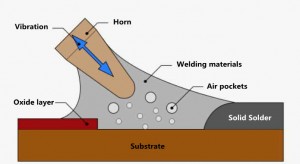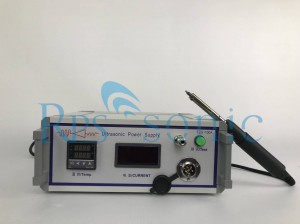Ultrasonic soldering is a flux-free soldering method that is considered more environmentally friendly than traditional soldering methods. Vibration and cavitation are used to remove surface oxide from welded surfaces, not chemical agents.
Ultrasonic soldering technology is different from ultrasonic plastic welding, which uses vibration to generate heat to melt the parts being connected. The principle of use of ultrasonic soldering is basically the same as the process of ultrasonic cleaning. The vibration energy causes cavitation in a water bath or cleaning solvent. The part immersed in the liquid medium, the surface is cleaned by the strong erosion of cavitation bubbles.
During ultrasonic soldering, heat from a separate energy source melts the solder before vibratory energy is applied. The molten solder is then used as an acoustic transmission medium for the ultrasonic vibrations. When high frequency vibrational energy is applied to molten solder, controlled acoustic cavitation is induced at the tip of the bonding tool in order to destroy and disperse surface oxides. The cavitation microbubbles rupture, cleaning all surfaces, allowing liquid solder to wet and bond pure metals.
Vibration also ensures that there are no voids in the solder joints, the energy of the vibration forces the liquid solder into the crevices and pores of the substrate. It helps seal the part and increases the surface area to which the solder can bond. Ultrasonic vibrations also force air bubbles out of the liquid solder, so this method makes solder joints suitable for high-vacuum applications that require hermetic sealing.
 Ultrasonic soldering allows joining of dissimilar materials and can be used for materials that are difficult to solder with conventional methods. Since no flux is required, users save time and cost in cleaning flux residues while reducing corrosion and increasing the durability of solder joints. The ultrasonic soldering method can be conveniently used for manual welding with the help of hand-held ultrasonic electric soldering iron equipment, and can also be grafted to ultrasonic welding machines and assembly lines for use.
Ultrasonic soldering allows joining of dissimilar materials and can be used for materials that are difficult to solder with conventional methods. Since no flux is required, users save time and cost in cleaning flux residues while reducing corrosion and increasing the durability of solder joints. The ultrasonic soldering method can be conveniently used for manual welding with the help of hand-held ultrasonic electric soldering iron equipment, and can also be grafted to ultrasonic welding machines and assembly lines for use.
Application of Ultrasonic Soldering Iron
Glass Jewelry Manufacturing
Coating/metallization of optical glasses
Fabrication of electrodes on glass and ceramic plates
Soldering of heating contacts in car rear window
Welding superconductors, components, ceramic accessories
Vacuum sealing of glass tubes, bonding of hardware fittings
Sealing of optical glass fibers (ferrule splicing)
Electrode bonding to front/back contacts of solar cells (crystalline, thin film)
Bonding of metal glass, liquid crystal glass, crystal oscillators, hybrid IC leads (dots)
Post time:Feb-07-2023





